How do I know if my house has asbestos in it?
Was your house built before the year 2000?
If so, there is a high likelihood of asbestos being in your property. Some older properties may have been refurbished in the 1960/70s using asbestos products.
If you are thinking of carrying out any refurbishment work on your property it would be advisable to have an asbestos survey carried out before any work begins, particularly if the house was built prior to 2000. An asbestos survey will ascertain where, if any, there is asbestos, the type of asbestos and the correct procedure for removal or encapsulation.
In a non-domestic premises it is a legal requirement to have an Asbestos Management Survey and Register.
Where is it found?
It can be difficult to identify asbestos, as it is often mixed with other materials. The picture shows common places where asbestos can be found.
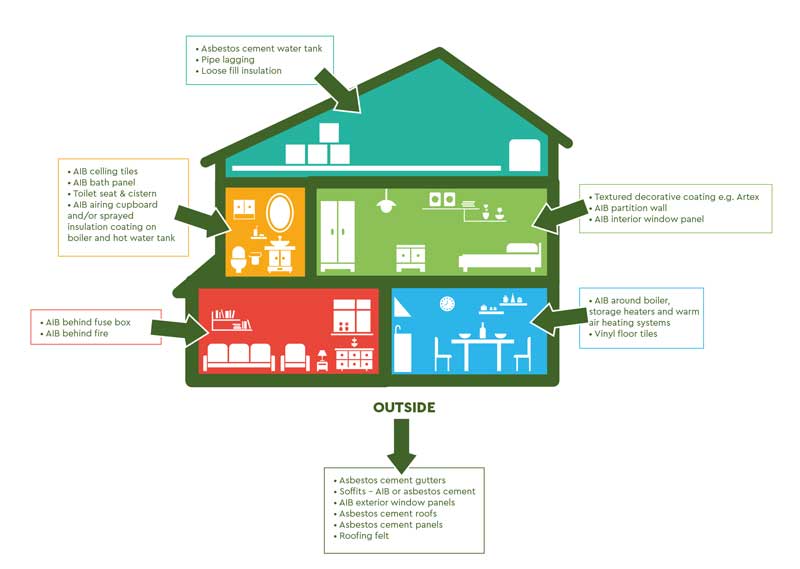
Note: AIB = Asbestos insulation Board
What does asbestos look like?
Examples of asbestos containing materials are; asbestos floor tiles, asbestos cement, textured coating (artex), asbestos insulation board, pipe lagging, asbestos rainwater goods, asbestos cement roof sheet, asbestos sink pads, asbestos boxing around pipework and asbestos may be found in many other materials and products found in the home and garden.
asbestos floor tiles

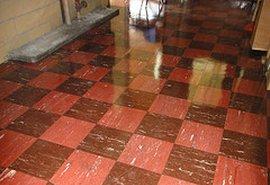
asbestos cement


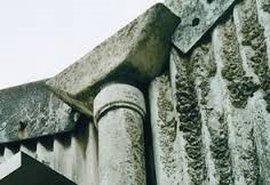
Textured coating (Artex)

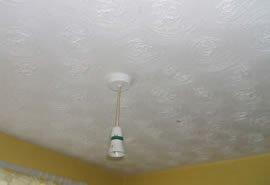
Asbestos insulation board
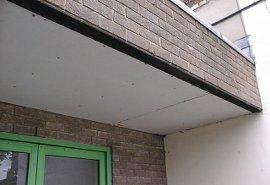
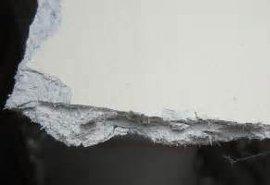
Asbestos pipe lagging

Licensed or non-licensed asbestos removal?
Working with asbestos containing materials (ACMs) is one of the UK’s most regulated industries. Most asbestos removal work will require a licensed contractor holding an asbestos licence from the HSE.
Asbestos removal falls into three main categories:
- Notifiable work – this type of work covers asbestos containing materials such as insulation board, pipe lagging and thermal insulation. The work must be notified to the HSE a minimum of 14 days before the work commences. The work is carried out under fully controlled conditions and will require an analyst to carry out a 4-stage clearance on completion.
- Notifiable non-licensed work (NNLW) – this type of work requires a notification to the HSE but a 14 day notification period is not required. It covers asbestos containing materials such as textured coating ceilings or badly damaged asbestos cement products for example.
- Non-notifiable work – this type of work covers asbestos containing materials such as asbestos cement in good condition and floor tiles for example.
A site visit will determine which category the asbestos falls into and whether the building needs an updated asbestos survey or additional bulk sampling.
Are there different types of asbestos?
Types of asbestos
There are 6 different types of asbestos which are split into two groups, Serpentine and Amphibole. Chrysotile is the only type of asbestos that is from the serpentine family and is known as white asbestos, their fibres are long, flexible and curved. Amosite, Crocidolite, Tremolite, Anthophyllite and Actinolite are types of asbestos that come from the Amphibole family, their fibres are straight and stiff, are generally brittle and rod or needle shaped. The three main types of asbestos which were commonly used are Crocidolite (commonly known as blue asbestos), Amosite (commonly known as brown asbestos) and Chrysotile (commonly known as white asbestos).
What can asbestos exposure lead to?
Asbestos Related Diseases
When asbestos fibres are breathed in, they can cause many diseases, below are some of the diseases they can cause:
Asbestosis
Asbestosis usually develops around 20-30 years after a person has breathed in fibres over a considerable length of time. Scarring of the lung similar to pneumoconiosis occurs over time, lung tissues thicken, causing pain and restricting breathing. It can indicate an increased risk of lung cancer or mesothelioma.
Lung cancer
A cancer of the lungs, the risk of which will be increased by exposure to large quantities of asbestos. Smoking and exposure to asbestos will increase the risk of Lung Cancer. It usually takes many years from first exposure before the disease develops.
Mesothelioma
A cancer of the chest lining or pleura, or peritoneum (the lining of the abdominal cavity). Mesothelioma develops after exposure to asbestos over time. It usually takes many years from first exposure to the onset of the disease.
Pleural Thickening
Pleural thickening is a lung disease where extensive scarring thickens the pleura, the thin membrane that covers the lungs. As the scar tissue grows, it can encase the lung and close off the space between the lungs and pleura, which can cause shortness of breath. Pleural thickening is caused by exposure to asbestos over a period of time and can increase the risk of Lung Cancer and Mesothelioma.
Pleural Plaques
A thickening in spots of the pleura or chest lining within time they decrease and heal, normally they do not cause any symptoms or problems. They are an indication of asbestos exposure and may increase the risk of Mesothelioma or lung cancer in the future.
What is Guano?
Excrement of birds and bats, accumulation of bird excrement which is harmful to health, unsightly and hazardous affecting many properties both old and new where pigeons have gained entry and over a short period of time can cause an awful amount of mess.
Is Guano Harmful to my health?
Yes, it is Harmful to your health as the fungus that grows on the guano (bird and bat droppings) creates harmful spores and if inhaled can affect the lungs and can cause an illness called Psittacosis.
How can we help with a pigeon problem?
D J Cleaning Ltd can clear and clean guano, we can also provide pigeon proofing for example spikes and netting. Removal and disposal, clean and disinfect properties affected by guano and dispose of carcasses.
When cleaning unwholesome properties are items salvageable?
We have a methodological approach to cleaning difficult properties and are often asked to save items of value or sentimentality, these can be cleaned and safely stored until the property is completed.



